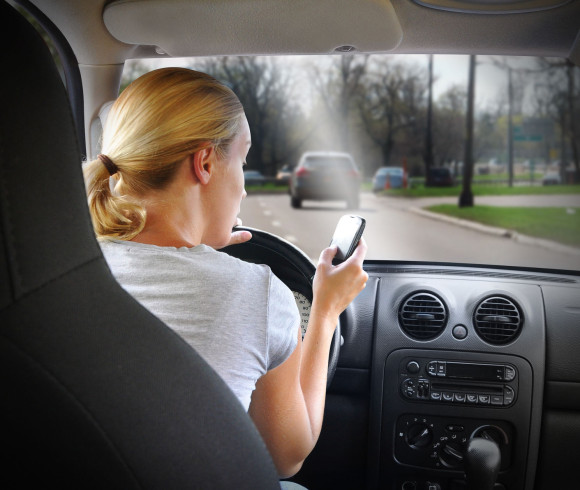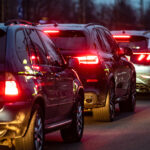U.S. highway safety officials called on smartphone makers to add features that would keep motorists from using functions linked to a surge in deaths due to distracted driving, a proposal that drew immediate opposition from the electronics industry.
The proposed voluntary guidelines ask device makers to take steps such as blocking some video displays and preventing manual text entry while vehicles are under way.
“As millions of Americans take to the roads for Thanksgiving gatherings, far too many are put at risk by drivers who are distracted by their cell phones,” said U.S. Transportation Secretary Anthony Foxx before the holiday. “These commonsense guidelines, grounded in the best research available, will help designers of mobile devices build products that cut down on distraction on the road.”
The proposal comes as highway deaths due to distractions reached at least 3,500 last year, and pits industry groups urging regulators to move cautiously against safety advocates who chided the government for acting too timidly. It also has implications for technology giants Apple Inc. and Alphabet Inc.’s Google, which are developing vehicle technology.
Among the ways the National Highway Traffic Safety Administration said manufacturers can meet the guidelines is to create a “driver mode” that limits functions when a vehicle’s transmission moves to “drive” from “park.” It said maps could continue to be displayed on a phone for navigation.
The Consumer Technology Association, a trade group whose members include top smartphone makers Apple Inc. and Samsung Electronics Co., characterized the guidelines as “extreme.”
Regulatory Overreach
“This regulatory overreach could thwart the innovative solutions and technologies that help drivers make safer decisions from ever coming to market,” Gary Shapiro, president of the Arlington, Virginia-based trade group said in an e-mailed statement. “NHTSA doesn’t have the authority to dictate the design of smartphone apps and other devices used in cars — its legal jurisdiction begins and ends with motor vehicle equipment.”
Shapiro called the proposed guidelines an “attempt by the outgoing administration to push out highly questionable, de facto regulations” before the administration of President-elect Donald J. Trump takes office.
CTIA, a trade group for wireless companies including AT&T Inc. and Verizon Communications Inc., criticized the proposal as “the wrong approach for consumers.”
“A regulatory path” can’t keep pace with efforts to reduce distractions “whether they arise from interacting with mobile or embedded devices or other activities like eating,” Tom Power, general counsel for the Washington-based trade group, said in an e-mailed message.
Carmaker ‘Encouraged’
The response from carmakers, which have been criticized for adding electronic distractions to vehicles, was more positive. Ford Motor Co. is still reviewing the proposal but is “encouraged NHTSA is looking at multiple factors beyond the vehicle to address driver distraction,” said Elizabeth Weigandt, a spokeswoman for the automaker.
The Alliance of Automobile Manufacturers, with members including Ford, General Motors Co. and Toyota Motor Corp., “will carefully review these guidelines,” Wade Newton, a spokesman for the trade group, said in an e-mail.
“It’s important to encourage drivers to use in-vehicle systems rather than handheld personal electronic devices that were not engineered for use in the driving environment,” Newton said.
U.S. highway deaths spiked to 35,092 last year in the highest one-year increase since 1966, the Transportation Department said in September. It attributed the 7.2 percent increase in highway deaths to more driving, drunk driving, speeding and distraction from phones and other devices.
Highway Deaths
Last year, 10 percent of traffic fatalities involved one or more distracted drivers, resulting in an 8.8 percent increase from distracted-related fatalities a year earlier, the transportation department said Wednesday.
“The problem of distracted driving has grown into an epidemic. These guidelines could help stem the increase in traffic deaths that we’ve seen in the last two years,” said William Wallace, policy analyst for Consumers Union, the policy arm of Consumer Reports. “There also needs to be a much broader effort with everyone — automakers, tech companies, regulators, and consumers — playing a role.”
NHTSA invited comments on the proposed guidelines. There are currently no safety guidelines for portable device technologies when they are used during driving.
The proposal would be the second phase of action against distracted driving. In 2013, the agency issued guidelines to automakers on communication, entertainment and navigation systems installed in vehicles.
Ban Sought
The latest NHTSA proposal doesn’t go nearly as far as what safety advocates and the government’s accident-investigation agency, the National Transportation Safety Board, have sought.
“While it is helpful to have some guidance, it’s a day late and a dollar short,” Deborah Hersman, president and chief executive officer of the National Safety Council, said in an e-mail. “Distraction results in far too many deaths and injuries. We need a smart solution, not feel-good guidelines.”
The NHTSA proposal falls short of a complete ban on mobile-device use by drivers favored by the NTSB, which investigates accidents and issues recommendations but can’t make rules.
“It creates a message to the driver that this technology is safe to use in the car,” Robert Molloy, director of the NTSB’s Office of Highway Safety, said in an interview. “That’s not a message that we want communicated.”
Undercount Danger
While Molloy said the safety board hasn’t had time to review the NHTSA proposal, it had taken too many years for the highway agency to act.
The NTSB says statistics on accidents related to driver distractions undercount the danger because local police departments often don’t check after a crash whether devices were in use.
Research shows the interference with a driver’s attention is equal whether the driver is holding the device or not. In several crashes investigated by the agency, drivers were on hands-free devices, Molloy said.
Only 14 states and the District of Columbia ban the use of handheld mobile phones. No jurisdictions prohibit the use of hands-free devices, according to the NTSB.
The NHTSA action also has the potential to complicate the race to provide technology for vehicles.
Apple and Google have both been developing vehicle technology in recent years. While some carmakers have signed up for the in-car entertainment and navigation systems from the tech giants — dubbed Carplay and Android Auto respectively — the rollout is slower than both tech companies promised.
Topics USA Auto Legislation InsurTech Tech Personal Auto
Was this article valuable?
Here are more articles you may enjoy.



 The Future Is Near for Self-Driving Trucks on US Roads
The Future Is Near for Self-Driving Trucks on US Roads  Allstate Tops Profit Estimates on Higher Premiums, Investment Returns
Allstate Tops Profit Estimates on Higher Premiums, Investment Returns  US to Require New Cars to Have Emergency Braking Systems by 2029
US to Require New Cars to Have Emergency Braking Systems by 2029  Rising Prices, Low Satisfaction Drive 49% of Customers to Shop For New Auto Insurance
Rising Prices, Low Satisfaction Drive 49% of Customers to Shop For New Auto Insurance 

